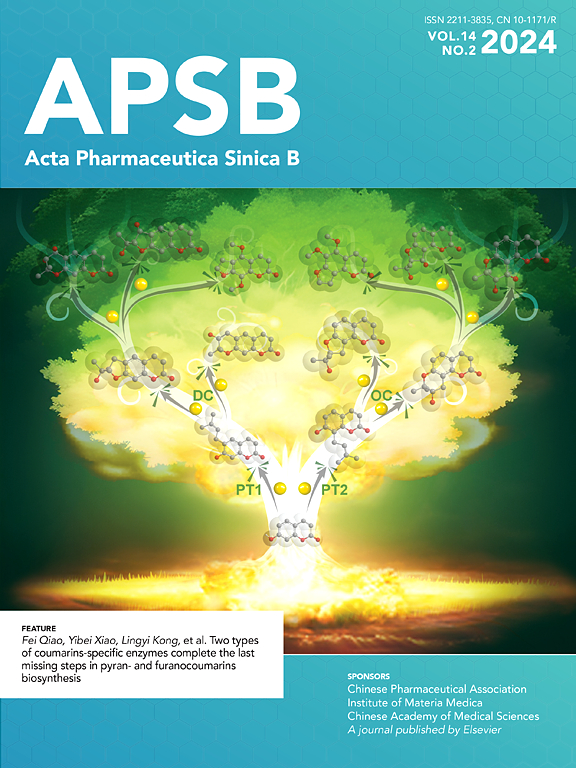BRD4通过与ALKBH5相互作用调控ESPL1 mRNA的m6A,调节乳腺癌的进展
IF 14.7
1区 医学
Q1 PHARMACOLOGY & PHARMACY
引用次数: 0
摘要
m6a甲基化RNA和染色质修饰之间的相互作用在很大程度上仍然未知。我们发现siRNA或其抑制剂(JQ1)靶向抑制含溴结构域蛋白4 (BRD4)可显著降低mRNA m6A水平,并通过增加去甲基化酶AlkB同源物5 (ALKBH5)的表达抑制乳腺癌(BC)细胞的恶性肿瘤。从机制上讲,抑制BRD4通过增强ALKBH5的3 ‘非翻译区(3 ’ utr)与rna结合蛋白RALY之间的结合,增加了ALKBH5 mRNA的稳定性。此外,BRD4作为泛素酶TRIM21和ALKBH5的支架,导致ALKBH5蛋白的泛素化和降解。jq1升高的ALKBH5随后使额外纺锤体样1 (ESPL1) mRNA去甲基化,减少ESPL1 mRNA与m6A阅读器胰岛素样生长因子2 mRNA结合蛋白3 (IGF2BP3)的结合,导致ESPL1 mRNA衰减。动物和临床研究证实了BRD4/ALKBH5/ESPL1通路在BC进展中的关键作用。此外,我们的研究揭示了组蛋白修饰和RNA甲基化之间的相互作用。本文章由计算机程序翻译,如有差异,请以英文原文为准。

BRD4 regulates m6A of ESPL1 mRNA via interaction with ALKBH5 to modulate breast cancer progression
The interaction between m6A-methylated RNA and chromatin modification remains largely unknown. We found that targeted inhibition of bromodomain-containing protein 4 (BRD4) by siRNA or its inhibitor (JQ1) significantly decreases mRNA m6A levels and suppresses the malignancy of breast cancer (BC) cells via increased expression of demethylase AlkB homolog 5 (ALKBH5). Mechanistically, inhibition of BRD4 increases the mRNA stability of ALKBH5 via enhanced binding between its 3′ untranslated regions (3′UTRs) with RNA-binding protein RALY. Further, BRD4 serves as a scaffold for ubiquitin enzymes tripartite motif containing-21 (TRIM21) and ALKBH5, resulting in the ubiquitination and degradation of ALKBH5 protein. JQ1-increased ALKBH5 then demethylates mRNA of extra spindle pole bodies like 1 (ESPL1) and reduces binding between ESPL1 mRNA and m6A reader insulin like growth factor 2 mRNA binding protein 3 (IGF2BP3), leading to decay of ESPL1 mRNA. Animal and clinical studies confirm a critical role of BRD4/ALKBH5/ESPL1 pathway in BC progression. Further, our study sheds light on the crosstalks between histone modification and RNA methylation.
求助全文
通过发布文献求助,成功后即可免费获取论文全文。
去求助
来源期刊

Acta Pharmaceutica Sinica. B
Pharmacology, Toxicology and Pharmaceutics-General Pharmacology, Toxicology and Pharmaceutics
CiteScore
22.40
自引率
5.50%
发文量
1051
审稿时长
19 weeks
期刊介绍:
The Journal of the Institute of Materia Medica, Chinese Academy of Medical Sciences, and the Chinese Pharmaceutical Association oversees the peer review process for Acta Pharmaceutica Sinica. B (APSB).
Published monthly in English, APSB is dedicated to disseminating significant original research articles, rapid communications, and high-quality reviews that highlight recent advances across various pharmaceutical sciences domains. These encompass pharmacology, pharmaceutics, medicinal chemistry, natural products, pharmacognosy, pharmaceutical analysis, and pharmacokinetics.
A part of the Acta Pharmaceutica Sinica series, established in 1953 and indexed in prominent databases like Chemical Abstracts, Index Medicus, SciFinder Scholar, Biological Abstracts, International Pharmaceutical Abstracts, Cambridge Scientific Abstracts, and Current Bibliography on Science and Technology, APSB is sponsored by the Institute of Materia Medica, Chinese Academy of Medical Sciences, and the Chinese Pharmaceutical Association. Its production and hosting are facilitated by Elsevier B.V. This collaborative effort ensures APSB's commitment to delivering valuable contributions to the pharmaceutical sciences community.
 求助内容:
求助内容: 应助结果提醒方式:
应助结果提醒方式:


